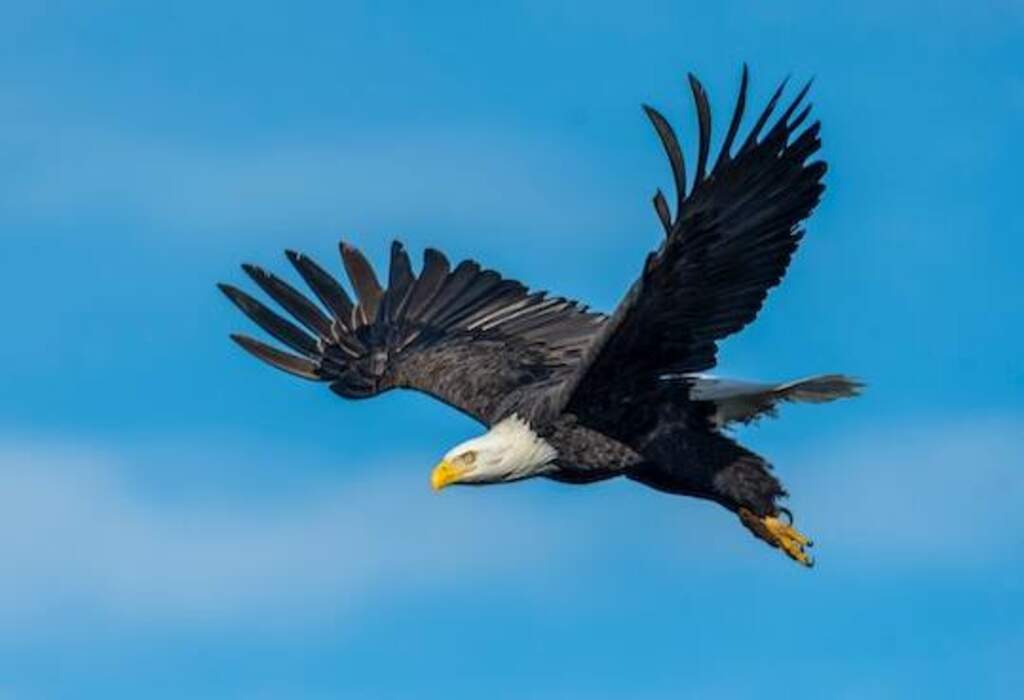Ready to take a thrilling plunge into the world of eagle acrobatics? Eagles are one of the most iconic and majestic birds in the world, known for their incredible hunting skills and impressive aerial acrobatics.
Among their many impressive abilities, their diving skills are particularly noteworthy. In this wild ride, we’ll uncover the secrets of “How Do Eagles Dive?”
We’ll explore the physics, anatomy, and hunting techniques behind their astonishing maneuvers, giving you a deeper appreciation for the remarkable capabilities of these fascinating birds.
Get ready for a dive into eagle mastery!
Table of Contents [show]
Key Takeaways
- Eagles use various hunting techniques such as stalking, soaring, and surprise attacks to hunt.
- Timing and control of the dive are critical components of a successful hunt, and there are three main types of dives: power, stooping, and hover.
- Eagles have become highly specialized hunters, adapting their diving skills to suit their ecological environments, with different species using unique techniques such as plunge-diving, stooping, and drop-diving.
- Positive reinforcement and conditioning techniques, along with breeding programs and conservation efforts, aid in the training and conservation of eagles.
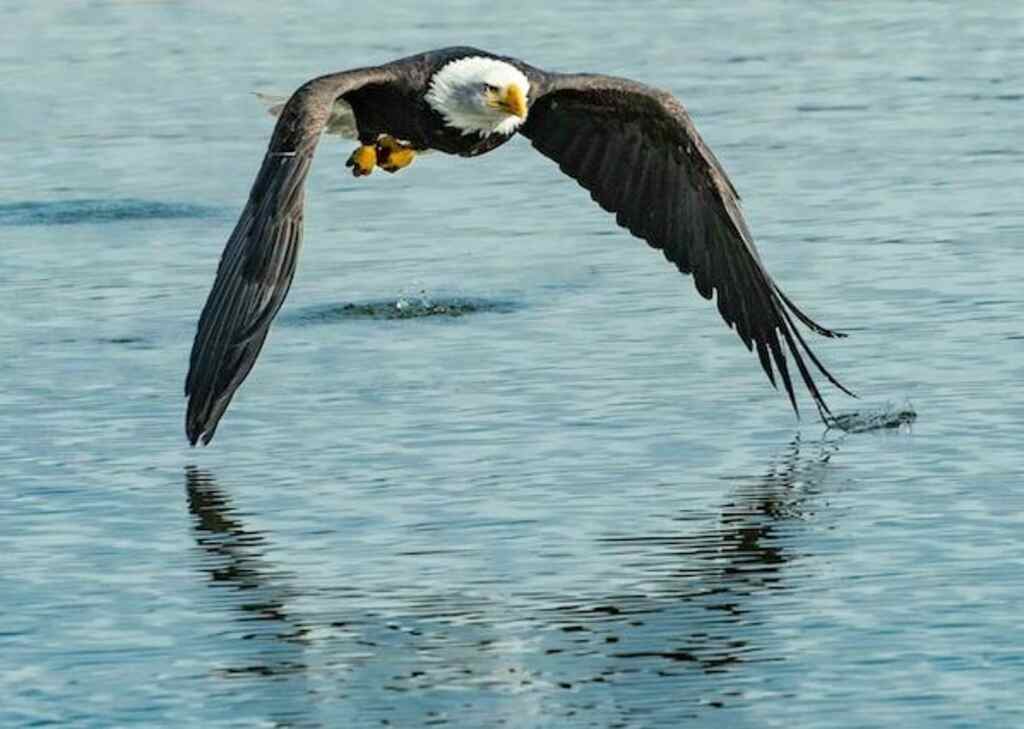
Overview of Eagle Hunting Skills
The proficiency of eagles in hunting is attributed to their exceptional visual acuity, speed, and agility in flight. Eagle hunting strategies involve a combination of various techniques such as stalking, soaring, and surprise attacks.
They have the ability to spot prey from a distance of more than a mile away and can dive at speeds of up to 200 miles per hour.
Prey selection is crucial for eagles as it determines their success in hunting. They typically hunt small mammals, birds, and fish, but they also have the ability to catch larger prey such as deer and antelope.
Understanding the physics of diving is essential to comprehend how eagles can make such a rapid descent towards their prey without getting injured.
How Do Eagles Dive
Eagles dive with extraordinary precision and speed to capture prey. They use their sharp eyesight to spot targets from great heights, then fold their wings to streamline their bodies.
This streamlined shape, along with powerful wingbeats, enables them to descend rapidly, reaching speeds up to 200 miles per hour.
With remarkable agility, they maneuver effortlessly through the air, adjusting their trajectory to align with their prey.
Finally, they extend their talons, grasping their target with remarkable accuracy and strength. Eagles’ diving prowess showcases their exceptional hunting abilities.
Understanding the Physics of Diving
One technique used by birds of prey to rapidly descend towards their prey involves a combination of aerodynamics and gravity.
Eagles, in particular, have developed a diving technique that allows them to reach speeds of up to 200 miles per hour.
This is made possible by their streamlined body shape, which reduces air resistance and allows them to move through the air with minimal drag.
Additionally, eagles use their wings and tail feathers to control their descent, adjusting their angle of attack to maximize their speed while maintaining control.
This diving technique is not unique to eagles, as other diving birds such as falcons and hawks also use similar techniques.
However, eagles are particularly well-suited for this type of hunting due to their size, strength, and sharp talons.
The physics of eagle diving has even found application in sports such as skydiving and base jumping, where thrill-seekers use similar techniques to achieve high speeds and perform aerial maneuvers.
In contrast to other diving birds, eagles rely heavily on their eyesight to locate prey from great distances. This will be discussed further in the subsequent section about the role of eyesight in eagle diving.
The Role of Eyesight in Eagle Diving
Eagle diving relies heavily on their acute vision, which plays a crucial role in their hunting success.
Their eyesight is so advanced that they can spot their prey from great heights and distances, allowing them to accurately target their prey during their steep and fast dives.
The importance of their eyesight cannot be overstated, as it enables them to adjust their flight path and maintain their trajectory even when their prey attempts to evade them.
The techniques used by eagles during diving are complex and require a high level of skill, which is only possible due to their exceptional eyesight.
These techniques include adjusting their wings, tail, and body position to control their speed and direction.
The next section will explore the hunting techniques of eagles in more detail.
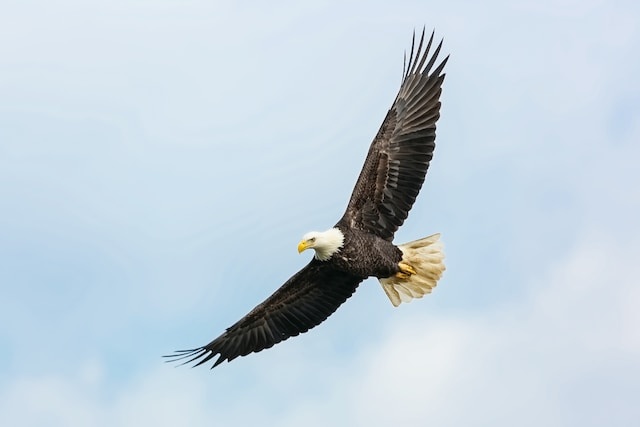
Hunting Techniques
Hunting techniques of these birds of prey involve a combination of physical attributes and strategic movements.
Eagles have sharp talons, powerful wings, and keen eyesight, which enable them to catch prey in a variety of ways.
Prey selection depends on the eagle’s size and hunting location. Bald eagles, for example, hunt fish and waterfowl, while golden eagles hunt larger mammals such as rabbits and deer.
Environmental factors such as wind direction, weather conditions, and terrain also play a role in their hunting success.
Eagles use various hunting techniques such as the stoop, where they dive at high speeds from great heights, or the ambush technique, where they surprise their prey from a hidden location.
Understanding these techniques is crucial for capturing prey and survival in the wild.
In the subsequent section about types of dives, we will explore in detail how eagles use their hunting techniques in different circumstances.
Types of Dives
The hunting techniques of eagles are diverse and complex, and one of the most impressive displays of their hunting prowess is their ability to execute different types of dives.
These dives are characterized by their speed, accuracy, and agility, and are essential for catching prey.
There are three main types of dives that eagles use: power dives, stooping dives, and hover dives, each with their own unique characteristics and purposes.
In this discussion, we will explore these different types of dives and how eagles utilize them in their hunting strategies.
Power Dives
During a power dive, eagles can reach speeds of up to 200 miles per hour, making it one of the most impressive and awe-inspiring sights in nature.
This type of dive is characterized by a steep angle, a rapid descent, and a sudden acceleration, as the eagle tucks its wings close to its body and plummets toward its prey.
The physiological effects of this maneuver are remarkable, as the eagle’s heart rate and metabolism increase dramatically, allowing the bird to maintain control and precision even at high speeds.
Training methods are crucial to developing the necessary skills for executing a power dive successfully, as eagles must learn to judge their distance, angle, and velocity precisely.
For those who admire the freedom and grace of these majestic birds, the power dive is a testament to their skill and strength, and a reminder of the incredible feats that nature can achieve.
Moving on to the next subtopic, stooping dives are another type of dive that is employed by eagles and other birds of prey.
Stooping Dives
With incredible speed and precision, birds of prey execute stooping dives to swiftly capture their prey from above.
Eagles, in particular, are known for their remarkable ability to dive at speeds that can reach up to 200 miles per hour.
This type of dive, also known as a power dive, involves a rapid descent from a high altitude with the wings tightly tucked against the body.
However, not all eagle dives are power dives. Some eagles, such as the Bald Eagle, use a technique called a stooping dive.
This type of dive is characterized by a steep and sudden descent towards the prey with the wings partially spread.
The stooping dive allows eagles to maintain a high level of speed and accuracy, making them effective hunters. Eagles are selective in their prey choices, often targeting fish, small mammals, and birds.
The stooping dive is a critical skill for eagles to master, as it allows them to quickly and efficiently capture their prey.
From the stoop, eagles can transition into a hover dive, where they hover in mid-air as they prepare to make their final descent towards their prey.
Hover Dives
Hover dives are a technique utilized by birds of prey to maintain a stationary position in the air, allowing them to survey their surroundings and prepare for their next move.
Eagles, in particular, use this method to locate their prey and calculate the ideal angle and speed for their stooping dive.
The benefits of hover dives include the ability to conserve energy and avoid detection from potential prey.
However, the impact of wind on hover dives can be significant, as it can affect the bird’s ability to maintain a stable position in the air.
To counteract this, eagles will adjust their wing position and body posture to compensate for the wind.
Understanding the mechanics behind hover dives is essential to comprehending the anatomy of a dive and how eagles are capable of such an impressive feat of speed and precision.
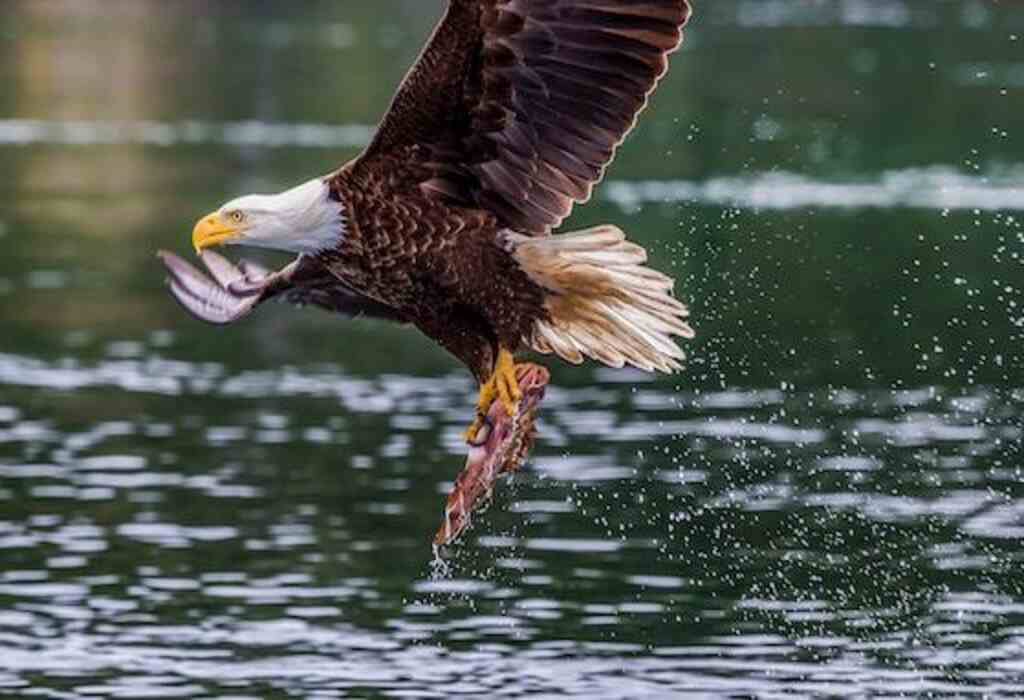
Anatomy of a Dive
The intricacies of an eagle’s dive can be better understood by examining the anatomy of the dive itself. Anatomy analysis reveals that an eagle’s body is perfectly designed for diving.
The aerodynamic shape of its body, with its broad chest and tapered wings, allows for a streamlined descent that minimizes air resistance.
Its keen eyesight and powerful talons enable it to accurately pinpoint and capture prey in mid-flight.
Performance factors such as the angle of descent, speed, and timing are all critical components of a successful dive.
Eagles can reach speeds of up to 200 miles per hour during a dive, which requires exceptional timing and control.
Their eyesight is so acute that they can spot a target from over a mile away, allowing them to adjust their angle of descent and speed accordingly.
Understanding the anatomy and performance factors of an eagle’s dive is essential for training and conditioning eagles for diving, which will be discussed in the subsequent section.
Training and Conditioning Eagles for Diving
Training and conditioning programs for eagles, such as the R.A.P.T.O.R. program, focus on developing the key skills needed for successful dives, including agility, strength, and precision.
Breeding programs and conservation efforts have also been implemented to ensure the continued success of these training programs.
These programs not only help eagles become adept divers, but also aid in the conservation of these magnificent birds of prey.
The R.A.P.T.O.R. program, for example, uses positive reinforcement and conditioning techniques to train eagles for a variety of tasks, including diving.
| Training Techniques | Description | Benefits |
|---|---|---|
| Weight Training | Utilizes weights to build strength and enhance muscular development. | Increases diving power and agility. |
| Obstacle Courses | Sets up challenging courses to improve agility, coordination, and reflexes. | Enhances maneuverability during dives. |
| Target Training | Trains eagles to focus on specific targets, improving precision and accuracy. | Enhances hunting success during dives. |
By incorporating these techniques into the R.A.P.T.O.R. program, eagles undergo rigorous training that hones their skills necessary for successful dives.
This comprehensive approach not only ensures their diving prowess, but also contributes to the conservation efforts and preservation of these majestic birds of prey.
These techniques help to develop and refine the skills necessary for successful diving.
With these training and breeding programs, eagles are able to reach their full potential and perform incredible feats of diving.
As we move into the subsequent section about unique eagle species and their diving abilities, it is fascinating to see how these training programs have allowed eagles to become masters of the skies and waters.
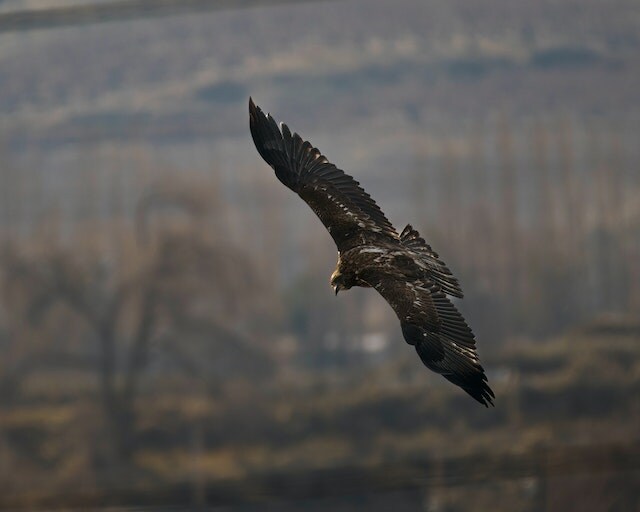
Unique Eagle Species and Their Diving Abilities
Different eagle species exhibit remarkable diving abilities that have evolved to suit their specific hunting environments, leaving observers in awe of their incredible aerial acrobatics and precision.
For instance, the White-tailed Eagle is known for its ‘plunge-diving’ technique, where it folds its wings and dives steeply to catch fish from the water surface.
The Golden Eagle, on the other hand, employs a ‘stooping’ technique, where it dives at high speeds to catch prey on land.
The Harpy Eagle, known for its powerful talons, uses a ‘drop-diving’ technique to surprise its prey from above.
These unique eagle species have adapted their diving techniques to their specific environments, enabling them to thrive in their respective habitats.
The evolution of eagle diving skills has been shaped by these diverse hunting techniques, which have helped them become efficient predators in their respective ecosystems.
The Evolution of Eagle Diving Skills
Adaptation to hunting environments has resulted in the evolution of unique diving skills in various eagle species, showcasing their incredible aerial abilities and precision.
Eagles have become highly specialized hunters, adapting their diving skills to suit their ecological environments.
For example, the African fish eagle has evolved to hunt fish, and has developed a unique diving skill that allows it to plunge into water at high speeds to catch its prey.
Similarly, the golden eagle, known for its adaptability, has evolved to hunt a variety of prey, and has developed high-speed diving skills that enable it to catch prey in mid-flight.
The evolution of these diving skills has been influenced by ecological factors, such as availability of prey, habitat, and competition from other predators.
As a result, eagles have become a symbol of freedom and are admired for their incredible aerial prowess.
Frequently Asked Questions
How long do eagles typically live in the wild?
The life expectancy of eagles in the wild varies depending on the species, with some living up to 30 years. Breeding habits also play a role, with monogamous pairs raising chicks together. Eagles are symbols of freedom, with their impressive wingspan and keen eyesight.
What are some common prey items for eagles?
Eagles hunt a variety of prey items including fish, mammals, and birds. Their hunting techniques vary depending on their habitat preferences, but they are known for their impressive speed, agility, and strength. All in all, eagles are skilled predators that excel at catching their prey.
What is the average wingspan of an eagle?
The average wingspan of an eagle varies by species, ranging from approximately 5 feet to over 7 feet. Eagle habitats are often near bodies of water or mountainous regions, and their hunting techniques involve using their sharp talons to catch prey while in flight.
How do eagles communicate with each other while hunting?
Eagle hunting tactics are communicated through vocalizations during hunting, allowing for coordinated and efficient hunting. These vocalizations serve to maintain distance and prevent collisions, while also alerting others of potential prey. This communication is a key aspect of successful hunting.
Are there any cultural or symbolic meanings associated with eagles and their diving abilities?
Eagle symbolism has historical significance in many cultures, representing power, freedom, and spirituality. Their diving abilities may represent a metaphor for overcoming obstacles or descending into the depths of the soul for self-discovery.
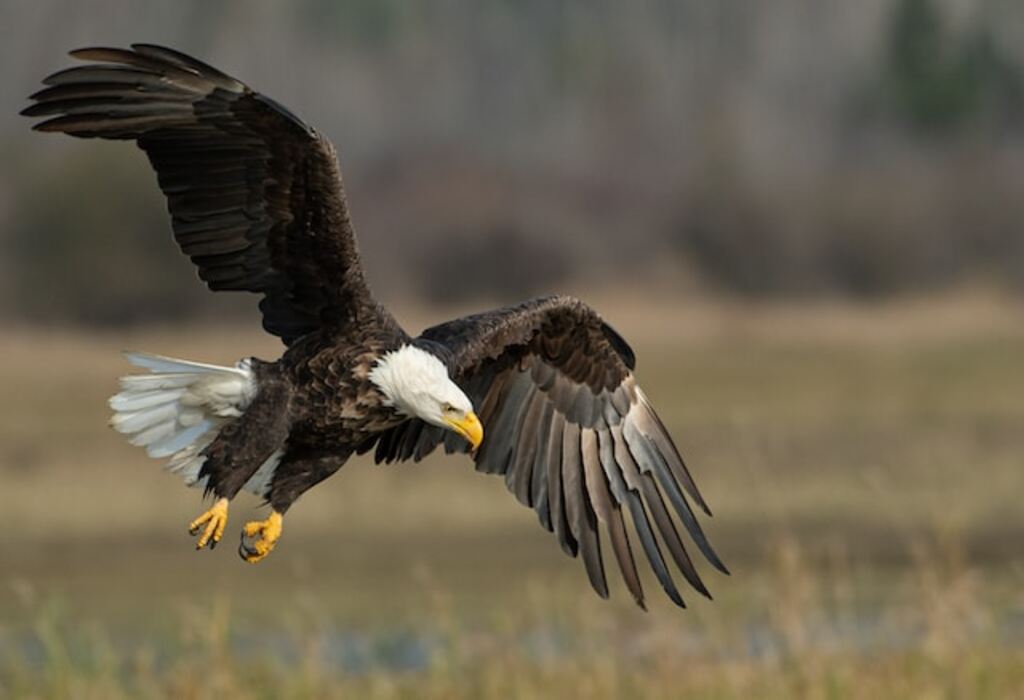
Conclusion
In conclusion, eagles possess impressive hunting skills, particularly in their diving abilities. Their keen eyesight, coupled with the laws of physics, allows them to execute successful dives and capture prey with great accuracy.
The anatomy of an eagle’s dive is complex, involving various body parts and movements.
Interestingly, research suggests that bald eagles can dive at speeds of up to 100 miles per hour, making them one of the fastest birds in the world.
This statistic highlights the impressive physical capabilities of eagles and their ability to adapt to their environment to become successful hunters.
Furthermore, the evolution of eagle diving skills is a testament to their innate adaptability and survival instincts.
Understanding the mechanics of eagle diving can provide valuable insights into the behavior and hunting habits of these magnificent birds.

